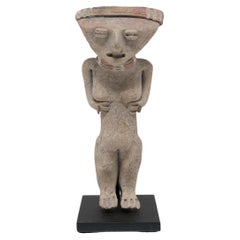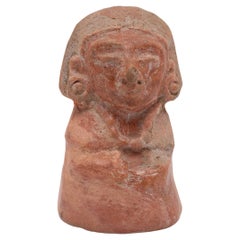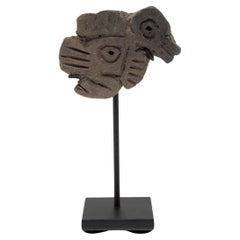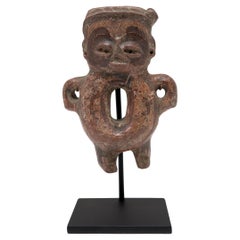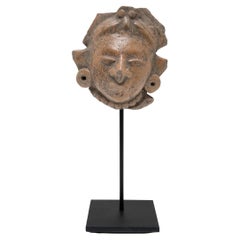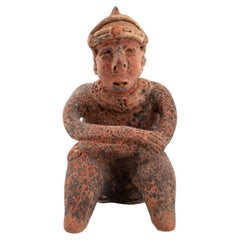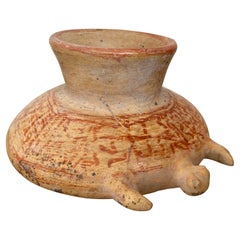Mexican Ceramics
8
to
1
7
8
8
8
8
1
37
27
1
12
23
2
2
3
5
8
1
20
8
8
6
6
Period: 18th Century and Earlier
Place of Origin: Mexican
Petite Chupicuaro Female Figure
Located in Chicago, IL
This standing female figure was crafted in 400-100 BC from the ancient Chupicuaro region of Mexico. The ceramic works of the Chupicuaro people are distinguished by their slanted, cof...
Category
15th Century and Earlier Pre-Columbian Antique Mexican Ceramics
Materials
Ceramic
Teotihuacan Redware Figure
Located in Chicago, IL
This intriguing redware figure was crafted in 400 A.D. from the ancient Teotihuacan region of Mexico. Earthenware figurines were made in great abundance throughout Teotihuacan's history. After 250 A.D. objects made from clay increased dramatically, serving a wide variety of purposes and functions from religious rituals to burial offerings.
Figurines like this commemorated important people and events within the city of Teotihuacan and other parts of Mesoamerica, portraying individuals of different rank and status such as soldiers, merchants, bureaucrats, and occasionally divinities. This figure is adorned with an elaborate headdress, a thick beaded necklace...
Category
15th Century and Earlier Pre-Columbian Antique Mexican Ceramics
Materials
Ceramic
Maya Bird Sello Stamp
Located in Chicago, IL
Stamps, or sellos, such as this one were common during the pre-Columbian period in Mesoamerica and most popular during the Formative Period that spanned the years between 1200-800 B....
Category
15th Century and Earlier Pre-Columbian Antique Mexican Ceramics
Materials
Ceramic
Teotihuacan Ceramic Head Fragment
Located in Chicago, IL
This intriguing head fragment was once attached to a bust or full effigy figurine crafted in 400 A.D. Mesoamerica. Earthenware figurines were made in great abundance throughout Teotihuacan's history. After 250 A.D. objects made from clay increased dramatically in Teotihuacan, serving a wide variety of purposes and functions from religious rituals to burial offerings.
Figurines like this commemorated important people and events within the city of Teotihuacan and other parts of Mesoamerica, portraying individuals of different rank and status such as soldiers, merchants, bureaucrats, and occasionally divinities. This figure is adorned with an elaborate coiffure or headdress and ear spools...
Category
15th Century and Earlier Pre-Columbian Antique Mexican Ceramics
Materials
Ceramic
Chupicuaro Redware Figure
Located in Chicago, IL
This standing effigy figure was crafted in 300 BC from the ancient Chupicuaro region of Mexico and was likely used as a ritual or burial offering. The ceramic works of the Chupicuaro...
Category
15th Century and Earlier Pre-Columbian Antique Mexican Ceramics
Materials
Ceramic
Teotihuacan Ceramic Head Fragment
Located in Chicago, IL
This intriguing head fragment was once attached to a bust or full effigy figurine crafted in 400 A.D. Mesoamerica. Earthenware figurines were made in great abundance throughout Teotihuacan's history. After 250 A.D. objects made from clay increased dramatically in Teotihuacan, serving a wide variety of purposes and functions from religious rituals to burial offerings.
Figurines like this commemorated important people and events within the city of Teotihuacan and other parts of Mesoamerica, portraying individuals of different rank and status such as soldiers, merchants, bureaucrats, and occasionally divinities. This figure is adorned with an elaborate headdress, a thick beaded necklace...
Category
15th Century and Earlier Pre-Columbian Antique Mexican Ceramics
Materials
Ceramic
Jalisco Kneeling Female Figure, ca. 400 AD
Located in Chicago, IL
This commanding earthenware figure is attributed to the Jalisco region of Western Mexico and dates to ca. 400 AD. Possibly depicting an ancestor, warrior, or mythical person, the fig...
Category
15th Century and Earlier Pre-Columbian Antique Mexican Ceramics
Materials
Earthenware
Pre-Columbian Ceramic Vessel from Mexico, Date Unknown
Located in San Miguel de Allende, Guanajuato
Prehispanic turtle vessel with human head and red paint, from the outskirts of Ixtlan del Rio, Nayarit, Mexico, date unknown. Appears to be a candleholder or copal burner. Rim on the...
Category
15th Century and Earlier Pre-Columbian Antique Mexican Ceramics
Materials
Ceramic
Related Items
Alan Wallwork Studio Pottery Split Pod Sculpture
By Alan Wallwork
Located in Bishop's Stortford, Hertfordshire
Stoneware studio pottery 'split pod' form designed by Alan Wallwork (British, 1931-2019) and dating from around 1980. The heavily made sculptural pod sta...
Category
1980s Modern Vintage Mexican Ceramics
Materials
Stoneware
Pre-Columbian Nayarit Seated Figure Redware Statue
Located in New York, NY
Ancient pre-Columbian, Nayarit, Mexican, circa 100 BCE to 250 CE, hand-built ceramic pottery redware sculpture of a seated male figure with arms crossed and wearing a headdress and m...
Category
15th Century and Earlier Pre-Columbian Antique Mexican Ceramics
Materials
Ceramic, Pottery
Maya Mam Large Red Jar Pre Columbian Design, Indigenous Pottery
Located in Huay Pix, MX
MAM Collection
Place of origin: Department of Huehuetenango, Guatemala
Collection of jars made of red clay. They have traditionally been used to c...
Category
2010s Pre-Columbian Mexican Ceramics
Materials
Clay
Rare dutch "Gaper" statue with monkey on his shoulder.
Located in Leuven , BE
A gaper is a stone or wooden figurehead, often depicting a Moor, Muslim, or North African. The figurehead first appeared in the late 16th century as a hangout sign used outside the storefronts of drug stores in the Netherlands. The meaning of gaper is the same in English; the figurehead is always displayed with an open mouth, sometimes with a pill resting on his tongue. The gaper's gaping tongue could represent the intake of medicine and grimace represents the bitter taste of the medicine. The gaper takes on various appearances that are symbolic of the origin for the pharmacist...
Category
20th Century Mexican Ceramics
Materials
Plaster
Vertical Sculpture Castaña Black Clay Burnished Clay Fired with Wood Removable
By La muerte tiene permiso
Located in London, GB
Castañas (chestnuts) is a sculpture made of a series of cups.
The individual pieces can be rearranged to create different shapes, and can also be us...
Category
2010s Mexican Ceramics
Materials
Clay
Mexican Vintage Tonala Pottery Hand Painted Bird
By Tonala Pottery
Located in North Hollywood, CA
Vintage Mexican Tonala hand painted pottery bird Folk Art.
Flora de la Cruz Acapulco Gro Mexico hand painted bird dove ceramic.
Warm earth tone polychrome colors with abstract desi...
Category
Mid-20th Century Folk Art Mexican Ceramics
Materials
Ceramic, Pottery
Mexican Vintage Ken Edwards Tonala Pottery Hand Painted Quail Bird
By Ken Edwards
Located in North Hollywood, CA
Vintage Ken Edwards Mexican ceramic quail bird form Tonala Pottery.
Beautiful vintage Mexican hand made and hand painted TONALA Art Pottery.
Deco...
Category
Mid-20th Century Folk Art Mexican Ceramics
Materials
Pottery
Mexican Tonala Pottery Hand Painted Bird Folk Art
By Tonala Pottery
Located in North Hollywood, CA
Vintage Mexican Tonala hand painted pottery bird Folk Art.
Flora de la Cruz Acapulco Gro Mexico hand painted bird dove ceramic.
Warm earth tone polych...
Category
Mid-20th Century Folk Art Mexican Ceramics
Materials
Pottery, Ceramic
Antique Miniature Staffordshire Pottery Spaniel Dog Figurine with Confetti Fur
By Staffordshire
Located in Philadelphia, PA
A fine antique English Staffordshire pottery figurine.
Depicting a seated Spaniel.
With confetti fur and painted black highlights.
Simply a wonderful Staffordshire dog figurine...
Category
Late 19th Century Victorian Antique Mexican Ceramics
Materials
Pottery
H 3.75 in W 2.63 in D 1.88 in
Maria H. Rahmer Figural Ceramic Sculpture
By Maria Rahmer
Located in New York, NY
Fabulous and large Maria H. Rahmer (1911-1998) figural sculpture of a boy holding fruit circa 1930s from Hungary. Great ceramic condition with signature H. Rahmer on the side of the ...
Category
1930s Vintage Mexican Ceramics
Materials
Ceramic
Charming Pair of Austrian 19th Century Polychromed Majolica Wall Sculptures
By Friedrich Goldscheider
Located in Los Angeles, CA
A fine and charming pair of Austrian 19th century polychromed majolica hanging wall sculptures of an elderly couple peeking through a window, probably by Friedrich Goldscheider (Goldscheider'sche Porzellan-Manufactur und Majolica-Fabrik.) Each wall sculpture depicting an elderly man wearing glasses and a traditional cap with his arms extended forward as if it was reading a book or a newspaper. The other depicting an elderly lady, also peeking through a window, wearing a laced cap with a bow tie and shawl over her shoulders, her arms are also extended forward as if it was reading a book or a newspaper. The male figure stamped on the back "78 - II ." The lady figure stamped on the back "37 - 79." Vienna, circa 1890-1900.
Man's height: 16 1/2 inches (41.9 cm.)
Man's width: 13 3/4 inches (34.9 cm.)
Depth: 8 1/2 inches (21.6 cm.)
Lady's height: 15 1/2 inches (39.4 cm.)
Lady's width: 13 3/4 inches (34.9 cm.)
Lady's depth: 6 1/2 inches (16.5 cm.)
Goldscheider Manufactory and Majolica Factory (German: Goldscheider'sche Porzellan-Manufactur und Majolica-Fabrik, (now) Goldscheider Keramik) is an Austrian ceramic manufactory.
In 1885, Friedrich Goldscheider came from the small Bohemian city of Pilsen to Vienna and founded the Goldscheider Manufactory and Majolica Factory. It became one of the most influential ceramic manufactories of terracotta, faience and bronze objects in Austria with subsidiaries in Paris, Leipzig and Florence. For over half a century Goldscheider created masterpieces of historical revivalism, Art Nouveau (Jugendstil) and Art Deco. Famous artists such as Josef Lorenzl, Stefan Dakon, Ida Meisinger and the two perhaps best known Austrian ceramic artists Michael Powolny and Vally Wieselthier worked for Goldscheider. Several of the artists who worked for Goldscheider also worked for other Viennese studios, such as Augarten, Keramos or for the German brands Rosenthal and Meissen.
The Goldscheider family emigrated in 1938 to United Kingdom and USA. Walter Goldscheider startet a new factory in Trenton, New Jersey and returned to Vienna in 1950. Marcel Goldscheider went to Stoke-on-Trent and produced figurative ceramics for Myott and opened his own studio in the 1950s in Hanley. Both brothers died in the early 1960s.
More than 10,000 different models were created over a period of three generations. Since the very beginning many of these won first prizes and gold medals at innumerable world fairs, exhibitions and trade fairs. Goldscheider figures...
Category
Late 19th Century Baroque Antique Mexican Ceramics
Materials
Majolica
H 16.5 in W 13.75 in D 8.5 in
Pair of Mid Century 1950s Howard Pierce Ceramic Quail Bird Sculpture Figurine
Located in San Diego, CA
Iconic pair of Howard Pierce ceramic quail bird figurines/sculptures dating from the 1950s. These are an iconic design. Great color and form. The larger ...
Category
Mid-20th Century Mexican Ceramics
Materials
Ceramic
H 5.75 in W 5 in D 3 in
Previously Available Items
Red Clay Armadillo Figure from Colima, Mexico, circa 7th Century
Located in San Miguel de Allende, Guanajuato
Red clay armadillo vessel most likely from Colima, Mexico. The zoomorphic figure shows significant wear and calcification from age. Impeccable workmanship is evident especially on th...
Category
15th Century and Earlier Primitive Antique Mexican Ceramics
Materials
Ceramic, Clay
Prehispanic Ceramic Turtle Vessel from Mexico, Date Unknown
Located in San Miguel de Allende, Guanajuato
Prehispanic ceramic turtle vessel with red paint, Located outside the village of Santiago, Nayarit, Mexico, date unknown.
Category
15th Century and Earlier Pre-Columbian Antique Mexican Ceramics
Materials
Ceramic
Petite Pre-Columbian Striped Chupícuaro Vessel
Located in Chicago, IL
This petite ceramic vessel was made by an artisan of the Chupícuaro culture, which was settled in Guanajuanto, Mexico from 500 BC-300 AD. Exhibiting a rich patina, the bowl's surface...
Category
15th Century and Earlier Pre-Columbian Antique Mexican Ceramics
Materials
Terracotta
Mayan Ulua Valley Banded Vessel, Ex-Andy Warhol
Located in San Pedro Garza Garcia, Nuevo Leon
Very fine terracotta jar in three tiers painted on the interior with dancing stick figures; on the exterior band of glyphoids at top showing human faces, lotus blossoms in the middle...
Category
15th Century and Earlier Pre-Columbian Antique Mexican Ceramics
Materials
Terracotta
Recently Viewed
View AllMore Ways To Browse
Cowden Wilcox Stoneware
Vintage Spongeware Pottery
Robinson Ransbottom Pottery Co. On Sale
Turkish Plate With Islamic Calligraphy
Benoist Favre
Bellarmine Jug
Cowden And Wilcox
Nampeyo Pottery
Bellarmine Stoneware Jugs
Antique 1 Gallon Crock
Derek Clarkson
Lagardo Eggheads
Robinson Ransbottom Spongeware
Bisque Nodders
Adam And Eve Bed
Mquan Wall Hanging
Robinson Ransbottom Cookie Jar
Antique 1 Gallon Stoneware Crock
